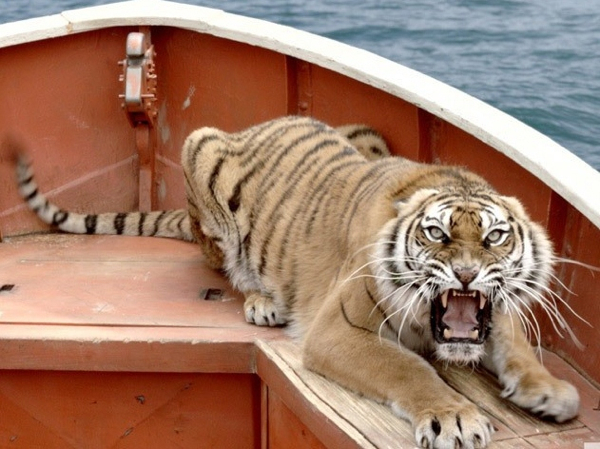Movie review by Greg Carlson
Ang Lee’s best and worst tendencies as a filmmaker are manifested in the visual smorgasbord “Life of Pi,” a rainbow-colored adaptation of the popular 2001 novel by Yann Martel. Cutting back and forth between the awesome spectacle contained within the see-it-to-believe-it story of a man and a tiger sharing space on a lifeboat and the leaden, prosaic didacticism of the scenes in which the title character recounts his unbelievable tale to an eager writer, Lee insists on showing and telling the audience when the former is cinematically preferable to the latter. The result is a flawed but intoxicating experience brimming with luscious compositions undercut somewhat by Lee’s insistence on unwelcome over-explanation.
Martel’s Booker Prize-winner seemingly belongs to the class of literature suggestive of the catnip adjective “unfilmable.” Alternately introspective and preachy, the fantasy fable of spiritual truth-seeking may strike some as an optimistic, New Age variation on “The Old Man and the Sea,” but both works surely depend upon the will to endure, exemplified via Hemingway’s veritable epithet “grace under pressure.” Perhaps someday a film will be made detailing the strange case of Martel’s erroneous recollection of an unflattering Updike review of Moacyr Scliar’s 1981 “Max and the Cats,” a novella in which a shipwreck survivor is stranded on a dinghy with a jaguar.
The logistics of photographing a Bengal tiger and a human being in close quarters depend on the illusion of proximity and the specialized skill sets of animal trainers and CGI artists. Lee succeeds mightily in his realization of maneater Richard Parker, and the sinewy beast takes on the substantial mantle of simultaneous symbol and flesh-and-blood feline. Newcomer Suraj Sharma plays Pi in the sections of the film dealing with the aftermath of the shipwreck, and while the actor gets the job done, one wishes that Lee had found a performer with the presence and depth of Irrfan Khan. Khan nearly manages to save the framing scenes in which the older Pi recounts his crucible, but those sections of the movie reek with the annoying sense that the viewer is not smart enough to discern the subtext.
While the scenes of Pi and Richard Parker lost and adrift rightfully receive the majority of attention over the tedious conversations of Rafe Spall’s unnamed writer and the older Pi, Lee also includes a third narrative trajectory establishing the hero’s childhood fascination with Christianity, Hinduism, and Islam. Set in India in the former French colony Pondicherry, the exposition lays out the interfaith and mono/polytheistic framework that will contribute to the explanation accompanying the surprise ending of the story. Screenwriter David Magee also adds a love interest that does not exist in the novel, a reasonable alteration that raises the emotional stakes of Pi’s departure from India.
Like “Avatar,” a movie to which “Life of Pi” has been frequently compared, Lee’s facility with technology in the service of image-making trumps the shortcomings of the script. The director lavishes painterly detail, sometimes combining incongruous foregrounds and backgrounds in thrilling tableaux, on the stylized world inhabited for 227 days by the young man and the tiger, and his investment in the natural world and its menagerie of inhabitants approaches the same level of interest exhibited over the decades by Terrence Malick. The beauty of sky and sea, imagined in the quiet, placid calm and the roiling, tumultuous chaos, engages the senses in a way that verbal expression cannot approach.
